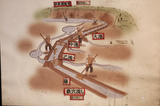Search Results
6/19/2025, 9:20:20 PM
The Japanese noticed that because iron oxides are denser than other minerals in the sand, they accumulate in places where the river changes direction or speed. The heavier iron sinks to the bottom and the lighter material is washed away. To amplify this effect, they deliberately created diversions in the river to increase the concentration of iron.
What you do is dam off a section of the river and then drag sand into it. Because iron is heavier than the other parts of the sand, it is the thing that gets left behind and everything else gets washed downstream.
With this method, you can get iron sands with 80% iron oxides by weight. That's more concentrated than high-quality iron ore. And since it has fewer impurities, it's an excellent source for high-quality steel.
If you heat up those iron oxides to over 1,250 degrees Celsius, you can break the bonds with oxygen and get pure iron. But pure iron is actually softer than bronze. So in its elemental state, iron provides no advantage.
But nature gave humans a lucky break. One of the few ways you can heat something up to 1,250 degrees is with charcoal, and charcoal is basically pure carbon. If you add just a little bit of carbon to iron, it creates an incredibly strong alloy: steel.
What you do is dam off a section of the river and then drag sand into it. Because iron is heavier than the other parts of the sand, it is the thing that gets left behind and everything else gets washed downstream.
With this method, you can get iron sands with 80% iron oxides by weight. That's more concentrated than high-quality iron ore. And since it has fewer impurities, it's an excellent source for high-quality steel.
If you heat up those iron oxides to over 1,250 degrees Celsius, you can break the bonds with oxygen and get pure iron. But pure iron is actually softer than bronze. So in its elemental state, iron provides no advantage.
But nature gave humans a lucky break. One of the few ways you can heat something up to 1,250 degrees is with charcoal, and charcoal is basically pure carbon. If you add just a little bit of carbon to iron, it creates an incredibly strong alloy: steel.
Page 1
